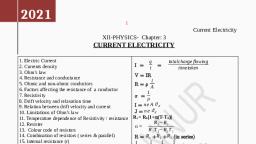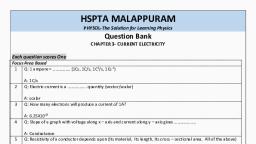Page 1 :
Electricity, TEXT BOOK QUESTIONS PAGE NO. 94, 1. What does an electric circuit mean?, Ans.An electric circuit consists of electric devices, switching devices, source of, electricity, etc. that are connected by conducting wires., 2. Define the unit of current., Ans.The unit of electric current is ampere (A). 1 A is defined as the flow of 1 Cof, charge through a wire in 1 s., 3. Calculate the number of electrons constituting one coulomb of charge., Ans.One electron possesses a charge of 1.6 × 10−19C, i.e., 1.6 × 10−19C of chargeis, contained in 1 electron., ∴ 1 C of charge is contained in=, , 1, 1.6×10−19, , =6.25 x1018 electron., , Therefore, 6.25 x 1018 electrons constitute one coulomb of charge., TEXT BOOK QUESTIONS PAGE NO. 96, 4. Name a device that helps to maintain a potential difference across a, conductor., Ans.A source of electricity such as cell, battery, power supply, etc., helps tomaintain a potential difference across a conductor., 5. What is meant by saying that the potential difference between two points is 1 V?, Ans.If 1 J of work is required to move a charge of amount 1 C from one point, toanother, then it is said that the potential difference between the two points is 1 V., , 6. How much energy is given to each coulomb of charge passing through a 6, Vbattery?, Ans.The energy given to each coulomb of charge is equal to the amount of, workrequired to move it. The amount of work is given by the expression,, Work done = Potential difference, Charge, Where, Charge = 1 C and Potential difference = 6 V, Work done = 6 1= 6 J, Therefore, 6 J of energy is given to each coulomb of charge passing, through a battery of 6 V, TEXT BOOK QUESTIONS PAGE NO. 103, 1. On what factors does the resistance of a conductor depend?, Ans.The resistance of a conductor depends upon the following factors:, Length of the conductor, Cross-sectional area of the conductor, Material of the conductor, Temperature of the conductor
Page 2 :
2. Will current flow more easily through a thick wire or a thin wire of the same, material, when connected to the same source? Why?, 𝑙, , Ans. Resistance of a wire,𝑅 = 𝜌 𝐴, Where,, R= resistance of the material,, 𝜌=Resistivity of the material of the wire, l = Length of the wire, A= Area of cross-section of the wire, Resistance is inversely proportional to the area of cross-section of the, wire. Thicker the wire, lower is the resistance of the wire and vice-versa., Therefore, current can flow more easily through a thick wire than a thin, wire., 3. Let the resistance of an electrical component remains constant while the, potential difference across the two ends of the component decreases to half of its, former value. What change will occur in the current through it?, Ans.The change in the current flowing through the component is given by, Ohm’slaw as,, V = IR, 𝐼=, , 𝑉, 𝑅, , Where,, Resistance of the electrical component = R, Potential difference = V, Current = I, The potential difference is reduced to half, keeping resistance constant., Let the new resistance be R' and the new amount of current be I '., Therefore, from Ohm’s law, we obtain the amount of new current., , Therefore, the amount of current flowing through the electrical, component is reduced by half., Why are coils of electric toasters and electric irons made of an alloy rather, than a pure metal?, Ans.The resistivity of an alloy is higher than the pure metal. Moreover, at, hightemperatures, the alloys do not melt readily. Hence, the coils of heating, appliances such as electric toasters and electric irons are made of an alloy, rather than a pure metal.
Page 3 :
(a) Which among iron and mercury is a better conductor?, Ans. (a) Resistivity of iron =10.0 ×10-8 m, Resistivity of mercury = 94.0 ×10 -8, m, Resistivity of mercury is more than that of iron. This implies that iron is a better, conductor than mercury., (b) Which material is the best conductor?, It can be observed from Table 12.2 that the resistivity of silver is the lowest, among the listed materials. Hence, it is the best conductor., , TEXT BOOK QUESTIONS PAGE NO. 107, 1. Draw a schematic diagram of a circuit consisting of a battery of three cells of, 2 V each, a 5 Ω resistor, an 8 Ω resistor, and a 12 Ω resistor, and a plug key,, all connected in series., Ans.Three cells of potential 2 V, each connected in series, is equivalent to, abattery of potential 2 V + 2 V + 2 V = 6V. The following circuit diagram shows, three resistors of resistances 5 Ω, 8 Ω and 12 Ω respectively connected in series, and a battery of potential 6 V, , 2. Redraw the circuit of question 1, putting in an ammeter to measure the current, through the resistors and a voltmeter to measure potential difference across the 12, Ω resistor. What would be the readings in the ammeter and the voltmeter?, Ans.To measure the current flowing through the resistors, an ammeter should, beconnected in the circuit in series with the resistors. To measure the, potential difference across the 12 Ω resistor, a voltmeter should be, connected parallel to this resistor, as shown in the following figure.
Page 4 :
TEXT BOOK QUESTIONS PAGE NO. 110, 1. Judge the equivalent resistance when the following are connected in parallel, (a) 1 Ω and 106Ω, (b) 1 Ω and 103Ω and 106Ω., Ans. (a) When 1 Ω and 106Ω are connected in parallel:, Let R be the equivalent resistance., , 2. An electric lamp of 100 Ω, a toaster of resistance 50 Ω, and a water filter, of resistance 500 Ω are connected in parallel to a 220 V source. What is, the resistance of an electric iron connected to the same source that takes, as much current as all three appliances, and what is the current through it?, Ans. Resistance of electric lamp, R1=, 100 Ω, Resistance of toaster, R2 = 50 Ω, Resistance of water filter, R3 = 500 Ω, Voltage of the source,, V = 20 V
Page 5 :
These are connected in parallel, as shown in the, following figure. Let R be the equivalent resistance of, the circuit., , 7.04 A of current is drawn by all the three given appliances., , Therefore, current drawn by an electric iron connected to the, same source of potential 220 V = 7.04 A, Let R’ be the resistance of the electric iron. According to Ohm’s law,, , Therefore, the resistance of the electric iron is 31.25 Ω and the, current flowing through it is 7.04 A., What are the advantages of connecting electrical devices in parallel, with the battery instead of connecting them in series?, Ans.There is no division of voltage among the appliances when, connected inparallel. The potential difference across each, appliance is equal to the supplied voltage. The total effective, resistance of the circuit can be reduced by connecting electrical, appliances in parallel., How can three resistors of resistances 2 Ω, 3 Ω and 6 Ω be connected, to give a total resistance of (a) 4 Ω, (b) 1 Ω?, Ans.There are three resistors of resistances 2 Ω, 3 Ω, and 6 Ω respectively., (a) The following circuit diagram shows the connection of the, three resistors. Here, 6 Ω and 3 Ω resistors are connected in, parallel.
Page 6 :
Therefore, their equivalent resistance will be given by, 1, , R=, , 1, , =, , 6x3, 6+ 3, , =2, 1, 1, +, +, R1, R2, 6, 3, This equivalent resistor of resistance 2 Ω is connected to a 2 Ω resistor in series., 1, , =, , 1, , Therefore, equivalent resistance of the circuit = 2 Ω + 2 Ω = 4 Ω, Hence, the total resistance of the circuit is 4 Ω, The following circuit diagram shows the connection of the three resistors., , All the resistors are connected in series. Therefore, their equivalent, resistance will be given as, 1, , R=, 1, , 1, , R1, , R2, , +, , 1, , =, +, , 1, , 1, , R3, , 2, , +, , 1, , =, +, , 3, , 1, , 1, , 3+2+ 1, , 6, , 6, , =, , 6, , =1, , 6, , Therefore, the total resistance of the circuit is 1 Ω, , What is (a) the highest, (b) the lowest total resistance that can be secured by, combinations of four coils of resistance 4 Ω, 8 Ω, 12 Ω, 24 Ω?, Ans.There are four coils of resistances 4 Ω, 8 Ω, 12 Ω and 24 Ω respectively, If these coils are connected in series, then the equivalent resistance will be, the highest, given by the sum 4 + 8 + 12 + 24 = 48 Ω, If these coils are connected in parallel, then the equivalent resistance will, be the lowest, given by, 1, , R=, 1+, , 1+, , =, 1, , +, , 1, , 1, 1 + 1 + 1 +, , =, 1, , R1, R2, R3, R4, 4, 8 12, 24, Therefore, 2 Ω is the lowest total resistance., , 1, 6 + 3+ 2+ 1, 24, , =, , 24 =2, 12
Page 7 :
INTEXT QUESTIONS PAGE NO.112, Why does the cord of an electric heater not glow while the heating element, does?, Ans.The heating element of an electric heater is a resistor. The amount of, heatproduced by it is proportional to its resistance. The resistance of the, element of an electric heater is very high. As current flows through the, heating element, it becomes too hot and glows red. On the other hand, the, resistance of the cord is low. It does not become red when current flows, through it., Compute the heat generated while transferring 96000 coulomb of charge in, one hour through a potential difference of 50 V., Ans. The amount of heat (H) produced is given by the Joule’s law of, heating as H=VIt, Where, Voltage, V = 50 V, Time, t = 1 h = 1 × 60 × 60 s, Amount of Charge, , Amount of current, I=, , =, , Time of flow of charge, , 96000 = 80 A, 1x 60 x 60, , 3, , 50 x 80/3 x 3600 = 4.8 x106 J, Therefore, the heat generated is 4.8 x106 J, , An electric iron of resistance 20 Ω takes a current of 5 A. Calculate the heat, developed in 30 s., Ans.The amount of heat (H) produced is given by the Joule’s law of, heating asH=VIt, Where, Current, I = 5 A, Time, t = 30 s, Voltage, V = Current × Resistance = 5 × 20 = 100 V, H = 100 x 5 x 30 = 1.5 x 104 J, Therefore, the amount of heat developed in the electric iron is 1.5 x 104 J, TEXT BOOK QUESTIONS PAGE NO. 114, What determines the rate at which energy is delivered by a current?, Ans.The rate of consumption of electric energy in an electric appliance is, calledelectric power. Hence, the rate at which energy is delivered by a, current is the power of the appliance., An electric motor takes 5 A from a 220 V line. Determine the power of the, motor and the energy consumed in 2 h.
Page 8 :
Ans. Power (P) is given by the expression, P = VI, Where,, Voltage, V = 220 V, Current, I = 5 A, P = 220 x 5 = 1100 W, Energy consumed by the motor = Pt, Where,, Time, t = 2 h = 2 × 60 × 60 = 7200 s, P = 1100 × 7200 = 7.92 × 106JTherefore, power, of the motor = 1100 W, Energy consumed by the motor = 7.92 × 106 J, , EXERCISE QUESTIONS PAGE NO. 115
























































































